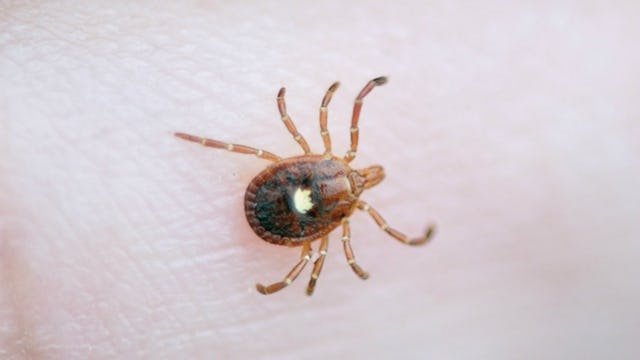Ticks That Trigger Meat And Dairy Allergies Are Spreading

Hands down, one of the worst things about warm weather is the number of bugs that come out to wreak havoc on the human population. Listen, I know that bugs have their place, and are actually very important members of the ecosystem, but when a mosquito is sucking my blood and leaving itchy pelts on my skin that will keep me up all night scratching, I have little compassion.
And did you know that there are some mosquitos out there who just happen to be injecting actual worms into people’s skin on top of everything else. Just…NO. Total barf-fest.
The fact is, besides how annoying and creepy bugs and their bites and stings can be, there are also some real dangers associated with certain kinds of bug bites. Bugs spread diseases that can be debilitating and even deadly. One of the top disease-injectors is the tick. Honestly, just thinking about ticks makes me cringe and shiver with fear.
And with good reason – ticks are notorious for spreading all kinds of icky diseases. Lyme disease is the one you’ve likely heard of most frequently, but there are several others that are pretty awful as well. And according to a recent report by CDC, insect-borne diseases – including ones spread by ticks, mosquitos, and fleas – have actually TRIPLED in the over the past 13 years. Triple YIKES.
One such tick-related health threat that has seen a marked increase in the past few years is from the lovely tick known as the lone star tick. This tick has a starring role in causing the people it bites to develop allergies to red meat and dairy (but the dairy component only happens in some cases: more on that in a sec).
Basically, if you get a tick bite from one of these MOFO’s, it may trigger a meat and dairy allergy in you. It’s called an alpha-gal allergy, and usually your symptoms develop several hours after eating the food (a delayed allergic reaction). As the College of Allergy, Asthma, and Immunology describes it, your symptoms can include hives, rash, nausea, vomiting, other stomach upset, difficulty breathing – and in some cases, anaphylaxis.
Ok, I’m never leaving my house again.
Dr. Scott Commins, an allergist at the University of North Carolina, Chapel Hill, tells TODAY that cases of tick-borne red meat and dairy allergies have actually been increasing as of late, and that it’s a huge, growing problem. As of now, there are about 5,000 cases of the allergy that he knows of. But that’s up from 3,500 just two years ago.
“It does seem like it’s really growing,” says Dr. Commins. “It appears the range of this tick is expanding… I also think it’s driven by folks are just encouraged to go outside more and perhaps they have more tick bites.”
See? Told you why never leaving my house was totally the best plan.
As TODAY explains, lone star ticks are most common in the southeast and eastern U.S., but they are finding those bastards in the northern U.S. as well. In fact, red meat and dairy allergies caused by lone star ticks can be found worldwide.
The good news is that the allergy only really involves red meat (beef, pork, or lamb), so you can eat chicken and fish if you have it. And it only includes dairy in some cases – and usually only from heavy-fat dairy products like ice cream (which would be very unfortunate even with the dairy-free substitutes out there). Dr. Commins says that at this point doctors aren’t sure if it just takes one bite by the lone star tick to give you the allergy, or if you would need several to develop it. But he says the allergy doesn’t discriminate, and even kids can get it.
The other (possibly) good news is that some patients do seem to out grow the allergy after a few years. At the time, there isn’t any treatment for it, though. They are working on a vaccine, but it’s not available yet.
Besides going to the doctor ASAP if you suddenly develop any symptoms of red meat or dairy allergy, it’s important that you take proper precaution to avoid ticks at all costs – and not just because of this particular danger, of course. Those jerks are hosts to a myriad of horrors.
Here is how the CDC recommends you best protect yourself from a tick-borne illness:
– Avoid tall grass when walking or hiking; stay on the main, cleared path.
– Use EPA-registered insect repellant. Yes, some include DEET other chemicals; just suck it up for safety’s sake. Besides DEET, other EPA recommended choices include picaridin, IR3535, oil of lemon eucalyptus, para-menthane-diol, or 2-undecanone.
– Use products containing permethrin to treat your clothing (like boots, pants, and socks) and gear (like tents).
– Bathe or shower after coming indoors.
– FULLY check your body and your children’s body for ticks. This might mean having someone else check those hard-to-see-places on you. And always have a grown-up check the kids.
– Remove any ticks ASAP, and call your doctor for next steps.
– Stick your clothes in a dryer on high heat for at least 10 minutes (or more for very wet clothes) to kill ticks.
Bottom line: PLEASE take every possible measure to protect you and your family from these creeps. Seriously, don’t take any chances. Of course, you don’t want to give yourself a panic attack about all this, because not all of us contract these awful insect-borne illnesses, and chances are you will be okay.
But it is always better to be safe than sorry, in my book, because the consequences of not being cautious are just too frightening to ignore.
This article was originally published on